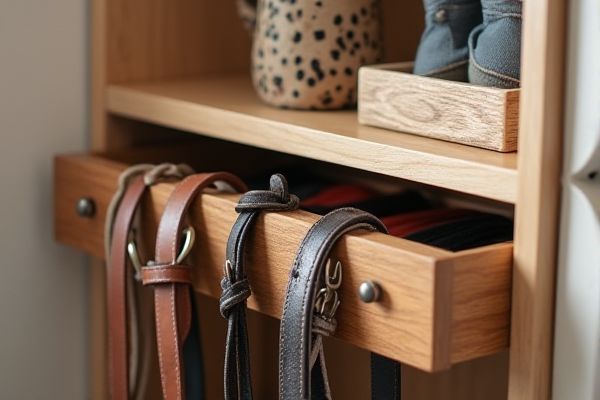
A belt hanger offers convenient vertical storage that saves space and keeps belts visible, while a belt drawer provides a more discreet, organized solution that protects your belts from damage. Discover which option suits your lifestyle best by exploring the pros and cons in the rest of the article.
Table of Comparison
| Feature | Belt Hanger | Belt Drawer |
|---|---|---|
| Design | Vertical hanging slots or hooks | Flat compartments or dividers inside a drawer |
| Space Efficiency | Saves horizontal space, uses vertical space | Compact, fits inside dresser or closet drawers |
| Accessibility | Easy to see and grab belts quickly | Belts lie flat, require opening drawer for access |
| Protection | Less protection; belts exposed | Better protection from dust and damage |
| Capacity | Varies; typically holds fewer belts | Higher capacity, customizable compartments |
| Installation | Mounted on wall or closet rod | Integrated into dresser or standalone drawer unit |
| Price Range | Generally affordable ($10-$40) | Can be pricier depending on material ($30-$100+) |
| Ideal For | Quick access, minimal space rooms | Organized storage, protection, larger collections |
Introduction to Belt Storage Solutions
Belt hangers and belt drawers are essential belt storage solutions designed to organize and protect belts efficiently. Belt hangers typically feature hooks or loops, allowing belts to be hung vertically to save space and prevent creasing. Belt drawers offer a flat, compartmentalized design that keeps belts neatly rolled or laid out, providing easy access while maintaining a clutter-free wardrobe.
What is a Belt Hanger?
A belt hanger is a compact storage solution designed to keep belts organized and easily accessible by hanging them vertically, preventing creases or damage. Unlike belt drawers, which store belts flat and require more space, belt hangers maximize closet efficiency by utilizing vertical space. You can choose a belt hanger with multiple hooks or loops, ideal for maintaining your belts' shape and visibility.
What is a Belt Drawer?
A belt drawer is a specialized storage solution designed to organize and protect belts by keeping them flat and easily accessible within a drawer compartment. Unlike belt hangers that hang belts vertically, belt drawers prevent creases and maintain the leather's shape by providing a horizontal storage space, often with dividers or padded sections. This method maximizes drawer space efficiency and preserves belt quality for long-term use.
Space Efficiency: Belt Hanger vs Belt Drawer
Belt hangers maximize vertical space by allowing multiple belts to be stored in a compact, visible manner, ideal for small closets or limited shelf areas. Belt drawers optimize horizontal space within dresser compartments, offering organized storage that conceals belts but may limit quick access and visibility. Choosing between a belt hanger and a belt drawer depends on prioritizing either accessibility and display or concealed, organized storage in confined spaces.
Accessibility and Convenience
Belt hangers provide quick visual access, allowing you to easily select and retrieve your belts without unfolding or rummaging through a drawer. Belt drawers offer a neat, contained storage solution, protecting belts from dust and damage but may require you to open and sift through compartments. Your choice depends on whether you prioritize immediate access or organized storage within your wardrobe.
Organization and Belt Visibility
Belt hangers provide superior belt visibility by allowing each belt to hang separately, making it easy to identify and select the desired belt quickly. Belt drawers offer organized storage by stacking belts horizontally, which maximizes space but can obscure visibility, requiring more effort to find specific belts. Choosing between belt hangers and belt drawers depends on prioritizing either visual accessibility or compact, contained organization.
Material and Design Options
Belt hangers typically feature durable materials like wood, metal, or plastic with open designs that allow easy visibility and ventilation, helping prevent belt deformation. Belt drawers, on the other hand, often incorporate soft-lined compartments made from materials such as felt or fabric inside wooden or MDF frames, providing a protective environment that prevents scratches and keeps belts neatly separated. Your choice depends on whether you prefer quick access and display or organized, cushioned storage for preserving belt quality.
Installation and Maintenance
Belt hangers require simple wall or closet rod installation, often involving screws or hooks, making them quick to set up with minimal tools. Belt drawers demand more precise fitting within existing drawers or custom-built compartments, sometimes needing professional installation for optimal organization and accessibility. Maintenance for belt hangers involves periodic dusting and ensuring hooks remain secure, while belt drawers require regular cleaning to prevent debris buildup and checking drawer smoothness to maintain easy access.
Cost Comparison: Hanger vs Drawer
Belt hangers are generally more cost-effective, offering a budget-friendly option for organizing belts with prices often ranging from $10 to $30. Belt drawers, while more expensive with costs typically between $50 and $150, provide better protection and dust-free storage for your belts. Your choice depends on balancing affordability with the desire for a more polished and contained accessory organization solution.
Which Belt Storage Solution is Best For You?
A belt hanger offers easy visibility and quick access, ideal for those who prioritize convenience and space-saving in smaller closets. Belt drawers provide organized, dust-free storage with the ability to neatly separate multiple belts, making them perfect for wardrobes with more room and a focus on maintaining belt quality. Choosing between the two depends on your closet size, organizational preferences, and how often you rotate your collection.
 homyna.com
homyna.com